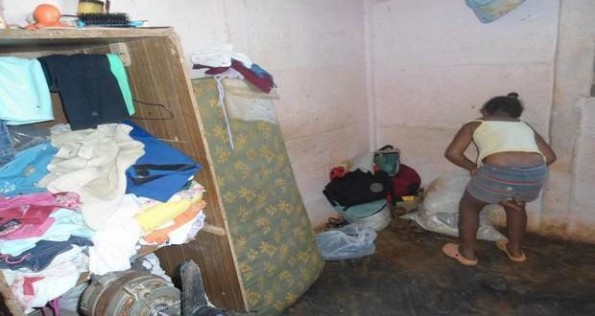Iván García, 26 February 2015 — José lives with his wife and five kids, crammed into a nine by twelve foot space with a wooden platform, in a shack in Santos Suárez, a slum south of Havana.
The tenement is a precarious spot where the electric cables hang from the roof, water runs down the narrow central passage from the plumbing leaks, and a disgusting smell of sewage hangs in your nose for hours.
That shack forms part of a group of ramshackle settlements where more than 90 thousand Havanans live, according to Joel, a housing official in the 10 de Octubre municipality.
There are worse places. On the outskirts of the capital, shantytowns are spreading like the invasive marabou weed. There are more than 50 of them. Houses made of sections of aluminium and cardboard, without any sanitation, where the occupants get their electricity supply by “informal” means.
But, going back to Santos Suárez. José says he is forty, but his sickly pale skin and his face puffed up from excessive drink, not enough to eat and poor quality of life make him look like an old man.
José is in that part of the population which doesn’t receive remittances and can’t get convertible pesos. He works at anything. Looking after flowerbeds, carrying debris, or ice cubes. On a good day, he makes 70 pesos, about $3. “All of it goes on food. And the rest on alcohol”, he says.
His family’s typical diet consists of two spoons of white rice, and a large spoon of stew once a week, a boiled egg and a quarter chicken or chopped beef mixed with soya which is distributed once a month via his ration book. “I just have a coffee for breakfast. My bread from the ration book I give to my kids.”
Ten years ago, he was imprisoned for stealing light bulbs and armchairs from houses in his area. “I stole from pure necessity. I sold the light bulbs or daylight colour tubes for 30 pesos. The iron chairs went for 10 CUC. I once got 25 chavitos (CUC) for a wooden chair. I was able to buy a cot for my daughter with that money”, José remembers, sitting in the doorway of a pharmacy in Serrano Street.
When you ask him about Raúl Castro’s economic reforms, or what he hopes for from the new diplomatic change of direction between Cuba and the United States, he puts on a poker face.
“What changes? With Raúl we poor people are even poorer. Here anyone who hasn’t any connections with the system or a family in Miami is in a difficult situation. I don’t even want to talk about the old people. There are a lot of things wrong about Fidel, but when he was in charge, the social services and what you could get through your ration book allowed you to live better. Not now. Every day Cubans like me get less from the government. Many people are happy to be on better terms with the Americans, but what can Obama do? He isn’t the president of Cuba,” he points out, while he takes a long swig of the worst possible alcohol out of a plastic bottle.
The streets of Havana swarm with hundreds of people like José asking for change, pulling out scraps from rubbish bins, or sleeping on cardboard boxes in uninhabitable buildings.
In the entrance of a building in Carmen Street, on the corner of 10th of October, about 10 people are there selling second-hand books, old shoes and junk. Nelson, a gay man about 60 years old, suffers from chronic diabetes. He sells old magazines. As far as he is concerned, the revolution can be summed up in a word: “shit”.
“It’s all just speeches. They said it was a revolution of humble people and for humble people, but it was a lie. Poor people were always badly off, but now we are more fucked than ever. What Raúl has brought us has been capitalism, of the worst kind. Fidel didn’t tolerate many things, including the homosexuals, but we lived a little better. The poor will always be poor, in a dictatorship or in a democracy”, asserts Nelson.
Like in the film Goodbye Lenin, directed by Wolfgang Becker, where the East Germans feel nostalgic about the Communist era, in Cuba, those whose lives are stuck in a tale of poverty, feel longing for the decade from 1970 to 1980, when the state gave you every nine days a pound of beef per person, through your ration book, a can of condensed milk cost 20 centavos and the shelves in the stores were full of Russian jams.
For Havanans like Nelson and José, you can’t eat democracy.
Photo: The conditions Yumila Lora Castillo, who is 8 years old and has a malignant tumor, is living in. Marelis Castillo, her mother, told Jorge Bello Domínguez, from the Cuban Community Communicators Network (who took the photo), that they haven’t even authorised the diet of meat and milk that people with cancer in Cuba are entitled to. A mother of two other children, Marelis lives in this inhuman situation in El Gabriel, in the municipality of Güira de Melena, Artemisa province, some 85 kilometers southwest of Havana.
Translated by GH

